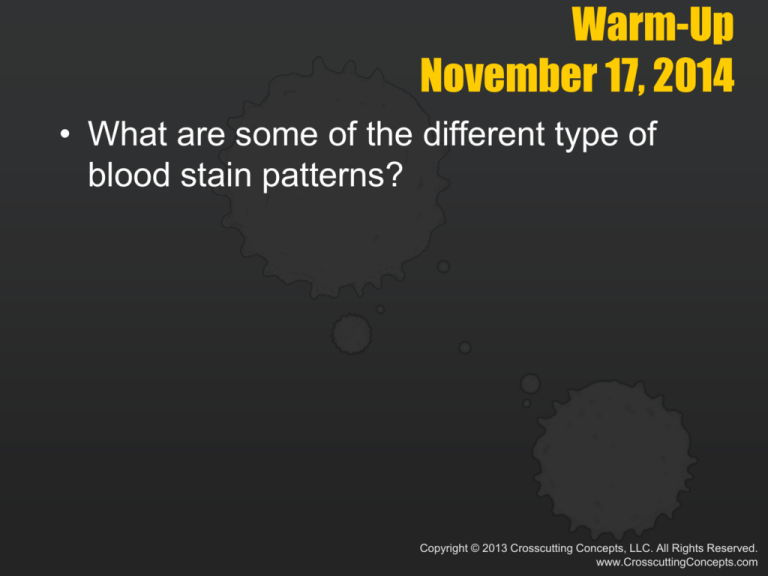
Warm-Up
November 17, 2014
• What are some of the different type of
blood stain patterns?
Copyright © 2013 Crosscutting Concepts, LLC. All Rights Reserved.
www.CrosscuttingConcepts.com
Objective
• SWBAT perform presumptive blood test to
determine if blood is present.
Copyright © 2013 Crosscutting Concepts, LLC. All Rights Reserved.
www.CrosscuttingConcepts.com
Agenda
1.
2.
3.
4.
5.
Crime 360
Blood Detection Pre-Lab
Blood Detection Overview
Detection Lab 1
Exit Slip
Copyright © 2013 Crosscutting Concepts, LLC. All Rights Reserved.
www.CrosscuttingConcepts.com
How Stuff Works
Underwater Detectives
T. Trimpe 2008 http://sciencespot.net/
Watch the video and then answer the questions.
http://videos.howstuffworks.com/science-channel/14374-discoveries-this-week-underwater-detectives-video.htm
1. What was the crime?
A. A body was dumped in the water.
B. A person fell over the side of a boat and drowned.
C. A boat was stolen.
2. Why wasn’t the “killer” worried about leaving evidence behind?
A. He knew the evidence couldn’t be traced back to him.
B. He figured the water would wash away all the evidence.
3. True or False?
Fingerprints are likely to remain on evidence found in the water.
4. What is the correct order for processing a water crime scene?
A. Photograph the area, gather evidence, and record measurements
B. Record measurements, photograph the area, and gather evidence
C. Photograph the area, record measurements, and gather evidence
The answers are …
1. What was the crime?
A. A body was dumped in the water.
B. A person fell over the side of a boat and drowned.
C. A boat was stolen.
2. Why wasn’t the “killer” worried about leaving evidence behind?
A. He knew the evidence couldn’t be traced back to him.
B. He figured the water would wash away all the evidence.
3. True or False?
Fingerprints are likely to remain on evidence found in the water.
4. What is the correct order for processing a water crime scene?
A. Photograph the area, gather evidence, and record measurements
B. Record measurements, photograph the area, and gather evidence
C. Photograph the area, record measurements, and gather evidence
Blood Spatter Labs
• You will be creating sample drop patterns using single drops and
multiple drops. We will also investigate the effect of motion and the
angle of impact on blood spatter.
• This can be messy! Be very careful to keep the blood on the paper
and not on yourself, the table, or floor.
• Hold you hand as steady as possible when making the drops.
Brace your wrist against the meter stick to help you.
• Get your materials from your teacher – paper, black marker, meter
stick, goggles, and a bottle of blood.
If you make a mess, clean it up immediately!
Lab 1: Single Droplets
• Label two large pieces of construction paper as shown below.
Single Drops
Group Members
Single Drops
Group Members
Keep your drops
in the correct area
of the paper.
25
50
75
100
• To do the lab, put on your goggles and hold the dropper bottle upside down so
that the end of it is 25 cm from the paper. GENTLY squeeze the bottle so that ONE
drop of blood is released and lands in the correct location on your paper. It should
NOT hit the meterstick.
• Repeat TWO more times at this height for a total of three drops.
• Continue making drops of blood on your paper, but put the drop in a different
area of the paper and change the height each time.
• When you are done, analyze your results and answer the questions on your
worksheet.
Make a mistake? Use a paper towel to wipe it off your paper!
Lab 1 Questions
Use your results to answer these questions.
What did you notice about the diameter of the parent droplets as you increased the
height of the drop?
How do the spines compare from the different heights?
Lab 2: Multiple Droplets
• Label a long piece of butcher paper (2 -3 meters in length) as shown below.
Multiple Drops
Group Members
Keep your drops
in the correct area
of the paper.
25
50
75
100
• To do the lab, put on your goggles and hold the dropper bottle upside down so that
the end of it is 25 cm from the paper. GENTLY squeeze the bottle so that ONE drop
of blood is released and lands in the correct location on your paper. The drop should
NOT hit the meterstick.
• Without moving your hand, release ONE more drop onto the first drop at that
height. If you make a mistake, wipe it off with a paper towel and try it again.
• Continue making drops of blood on your paper so you have three sets for each
height.
• When you are done, analyze your results and answer the questions on your
worksheet. Clean up your area and put away your materials before you leave class.
Lab 2 Questions
Use your results to answer these questions.
What happened when one drop landed on top of another one?
What did you notice about the diameter of the parent droplets as you increased the
height of the drop?
What do you notice about the diameter of the satellite spatter as you increased the
height of the drop?
Lab 3: Motion Droplets
• During this lab, you will see how motion affects the size and shape of the
droplets and spines. You will need a long piece of butcher paper (4-5 meters in
length) and tape to secure it to the floor. You will also need safety goggles.
• To do the lab, you will need to hold the dropper bottle upside down so that your
hand is out and away from your body (waist level), but is still over the paper.
• Start off walking at a SLOW WALKING RATE along the paper strip from one
end to the other and GENTLY squeeze the bottle as you walk so that blood is
released ONE DROP at a time. Be sure that all the drops land on your paper strip.
•Repeat this procedure using a NORMAL WALKING RATE and a FAST
WALKING RATE.
Miss the paper? Use a paper
towel to wipe it off the floor!
Walking Direction
• When you are done, analyze your results and answer the questions on your
worksheet. Clean up your area and put away your materials before you leave class.
Lab 3 Questions
Use your results to answer these questions.
Draw a sketch of the droplets showing the size, shape, and/or distance between
them at each speed in the chart below.
What did you notice about the shape of the droplets as you increased your walking
speed?
What did you notice about the spines as you increased your walking speed?
What did you notice about the distance between the droplets as you increased your
walking speed?
Copyright © 2013 Crosscutting Concepts, LLC. All Rights Reserved.
www.CrosscuttingConcepts.com
Pre Lab Questions
• Complete the Pre-Lab questions using the
information that is posted on the wiki page
Copyright © 2013 Crosscutting Concepts, LLC. All Rights Reserved.
www.CrosscuttingConcepts.com
Blood Stain Evidence
• Blood is a type of biological evidence that
can connect a suspect to a victim or object.
• White blood cells contain DNA which may be
used to identify an individual from a blood
sample.
• Lab testing can differentiate between human
and animal blood by protein or DNA analysis.
Copyright © 2013 Crosscutting Concepts, LLC. All Rights Reserved.
www.CrosscuttingConcepts.com
Biological Properties of Blood
• Blood delivers nutrients and oxygen to the
cells and transports waste products away
from cells.
• Red blood cells
carry oxygen
and carbon
dioxide.
Copyright © 2013 Crosscutting Concepts, LLC. All Rights Reserved.
www.CrosscuttingConcepts.com
Biological Properties of Blood
• White blood cells come in many varieties that
fight off infection in different ways, such as by
generating antibodies or breaking down intruder
cells.
• They also contain DNA.
Copyright © 2013 Crosscutting Concepts, LLC. All Rights Reserved.
www.CrosscuttingConcepts.com
Biological Properties of Blood
• Platelets assist in clotting.
Copyright © 2013 Crosscutting Concepts, LLC. All Rights Reserved.
www.CrosscuttingConcepts.com
Approximate Blood Components
platelets
3.9%
red blood cells
41.0%
white blood cells
0.1%
plasma
55.0%
Copyright © 2013 Crosscutting Concepts, LLC. All Rights Reserved.
www.CrosscuttingConcepts.com
Biological Properties of Blood
• Main elements used in forensic labs:
– Red blood cells
– Serum proteins
• Red blood cells have structures called
antigens on their surfaces. They are
grouped into classification systems
determined by their relationship to one
another (blood type).
Copyright © 2013 Crosscutting Concepts, LLC. All Rights Reserved.
www.CrosscuttingConcepts.com
Biological Properties of Blood
• Serum proteins such as antibodies are used
to test the sample to confirm that it is blood.
• An antibody activates or destroys a specific
antigen which allows for particular reactions
to occur when specific groups of antigens
and antibodies are mixed.
• These reactions allow for determination of
blood type.
Copyright © 2013 Crosscutting Concepts, LLC. All Rights Reserved.
www.CrosscuttingConcepts.com
Biological Properties of Blood
• The ABO group system for blood typing was first
used in the early 1970’s to link blood to an
individual.
• An individual that is type A has A antigens on their
red blood cells.
• Type B has B antigens on their red blood cells.
• Type AB has both A and B antigens.
• Type O has neither A or B antigens.
Copyright © 2013 Crosscutting Concepts, LLC. All Rights Reserved.
www.CrosscuttingConcepts.com
Biological Properties of Blood
• In addition to the A and B antigens there is
also another antigen, the Rh factor.
• Its presence is indicated by a positive sign
and its absence is indicated by a negative
sign.
• This is appended after the A/B/O indicator.
Copyright © 2013 Crosscutting Concepts, LLC. All Rights Reserved.
www.CrosscuttingConcepts.com
Blood Type Frequency
Type
African
American
Asian
Caucasian
Hispanic
O+
47%
39%
37%
53%
O-
4%
1%
8%
4%
A+
24%
27%
33%
29%
A-
2%
0.5%
7%
2%
B+
18%
25%
9%
9%
B-
1%
0.4%
2%
1%
AB+
4%
7%
3%
2%
AB-
0.3%
0.1%
1%
0.2%
Copyright © 2013 Crosscutting Concepts, LLC. All Rights Reserved.
www.CrosscuttingConcepts.com
Blood Origin Testing
• Two categories of tests are available for
investigators.
• Presumptive tests are used to quickly
determine whether an unknown substance
is blood in the field. They are prone to
false positives.
• Confirmatory tests must be done at a lab
and provide much more accurate results.
Copyright © 2013 Crosscutting Concepts, LLC. All Rights Reserved.
www.CrosscuttingConcepts.com
Blood Origin Testing
• Two categories of presumptive tests are:
– Color changing tests
• Luminol, Benzidine, Phenolphtalein, TMB /
Hemastix
– Glowing reaction tests
• fluorescein
Copyright © 2013 Crosscutting Concepts, LLC. All Rights Reserved.
www.CrosscuttingConcepts.com
Phenolphthalein Presumptive Test
• This test is better known as the Kastle-Meyer
test.
• In a positive reaction the reduced
phenolphthalein will turn bright pink because
the phenolphthalein is oxidized by hydrogen
peroxide in the presence of hemoglobin.
• Phenolphthalein reagents give false positives
when vegetable materials are present.
Copyright © 2013 Crosscutting Concepts, LLC. All Rights Reserved.
www.CrosscuttingConcepts.com
TMB / Hemastix Presumptive Test
• This test is performed with commercial
plastic strips with a treated filter at one
end.
• A test swab is moistened with water and
placed in contact with the stain. The swab
is then placed onto the tip of the strip.
• If blood is present the hemastix strip will
turn green.
Copyright © 2013 Crosscutting Concepts, LLC. All Rights Reserved.
www.CrosscuttingConcepts.com
Luminol Presumptive Test
• Luminol tests for latent bloodstains. It can detect
blood that has been diluted up to 1 in 10,000,000.
• When luminol and hydrogen peroxide are applied
to the bloodstain the luminol produces a bluewhite to yellow-green light.
• Luminol can affect some testing processes but
does not affect most blood typing or DNA
analysis.
• It produces a false positive with plant enzymes,
oxidizers, metals, and chlorine.
Copyright © 2013 Crosscutting Concepts, LLC. All Rights Reserved.
www.CrosscuttingConcepts.com
Fluorescein Presumptive Test
• Fluorescein tests for latent bloodstains by
fluorescing under ultraviolet light.
• It can even detect blood stains that have
been cleaned with solvents such as bleach.
• Fluorescein can also be applied to vertical
surfaces, unlike luminol.
• Copper and hypochlorite will cause false
positives.
Copyright © 2013 Crosscutting Concepts, LLC. All Rights Reserved.
www.CrosscuttingConcepts.com
Presumptive Test Summary
Presumptive Test
Indication of
Positive
Situation Used
Phenolphtalein
Bright pink color on visible stains
False Positives
Vegetable
material
(potatoes and
horseradish)
Tetramethylbenzidine Green to blue(TMB) / Hemastix
green color
on visible stains
Oxidizing agents,
catalyst,
vegetable
peroxidase,
cosmetics
Luminol
Blue-white to
yellow-green
light
latent blood
Plant enzymes,
oxidizing agents,
metals, chlorine
Fluorescein
Fluoresce with
UV light source
latent blood,
vertical surface
Copper,
hypochlorite
Copyright © 2013 Crosscutting Concepts, LLC. All Rights Reserved.
www.CrosscuttingConcepts.com
Blood Origin Testing
• Once a stain has been characterized as
blood through a presumptive test it is
collected and stored for confirmatory
testing.
• The two most common confirmatory tests
are the Takayama and Trichmann tests.
Copyright © 2013 Crosscutting Concepts, LLC. All Rights Reserved.
www.CrosscuttingConcepts.com
Takayama Confirmatory Test
• The Takayama test is performed by
adding an alkaline solution with a specific
structure of hemoglobin to the stain on a
microscope slide.
• If blood is present, pink crystals will be
observed as the slide is heated.
Copyright © 2013 Crosscutting Concepts, LLC. All Rights Reserved.
www.CrosscuttingConcepts.com
Trichmann Confirmatory Test
• The Trichmann test is performed by adding a
small amount of chloride containing acetic
acid to the blood sample on a microscope
slide.
• Small crystals form on the slide as it is
heated if blood is present.
• Once the stain is confirmed as blood, it must
be tested to determine if the source is human
or animal.
Copyright © 2013 Crosscutting Concepts, LLC. All Rights Reserved.
www.CrosscuttingConcepts.com
Blood Origin Testing
• The precipitin test will determine whether the stain is of
human or animal origin.
• The precipitin test uses an antigen that is designed to
destroy human blood.
• This test takes advantage of the fact that antigens and
antibodies naturally move toward each other on a gel plate.
• The extracted blood stain (antigen) and the human
antiserum (antibody) are placed in separate holes opposite
each other on the gel. If the blood is human, a line of
precipitation forms where the antigens and antibodies meet.
Copyright © 2013 Crosscutting Concepts, LLC. All Rights Reserved.
www.CrosscuttingConcepts.com
Blood Properties
• Since the 1990’s DNA found in the blood
and other bodily fluids has been used to
identify an individual, like a genetic
fingerprint.
Copyright © 2013 Crosscutting Concepts, LLC. All Rights Reserved.
www.CrosscuttingConcepts.com
Blood Properties
• DNA is unique to the individual, whereas
blood typing can only eliminate an
individual as a suspect. Blood type is
class evidence and DNA is individual
evidence.
• The process of genetic fingerprinting is
called DNA profiling or DNA typing.
Copyright © 2013 Crosscutting Concepts, LLC. All Rights Reserved.
www.CrosscuttingConcepts.com
Detection Lab 1
• Follow the lab procedures and record your
data on the data collection sheet
• Make sure you observe the reactions
within 3 minutes – if it is longer than that
then the test is invalid
Copyright © 2013 Crosscutting Concepts, LLC. All Rights Reserved.
www.CrosscuttingConcepts.com
Exit Slip
November 17, 2014
• Go to m.socrative.com and enter 417101
• Question: What did you observe when
you tested the positive and negative
control card?
Copyright © 2013 Crosscutting Concepts, LLC. All Rights Reserved.
www.CrosscuttingConcepts.com

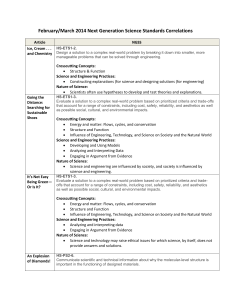
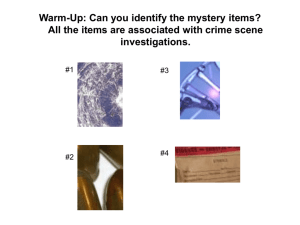

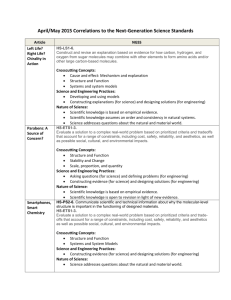
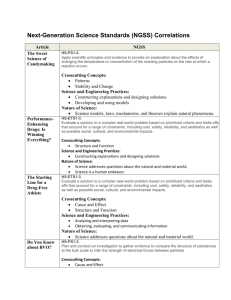
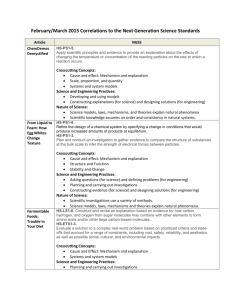
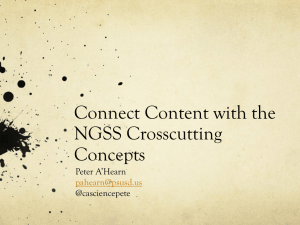
![Your_Solutions_LLC_-_New_Business3[1]](http://s2.studylib.net/store/data/005544494_1-444a738d95c4d66d28ef7ef4e25c86f0-300x300.png)